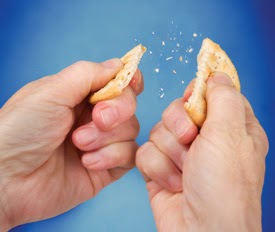 We’ve just finished reading a great article, ‘Eating with our ears: assessing the importance of the sounds of consumption on our perception and enjoyment of multisensory flavour experiences’ by Charles Spence.
We’ve just finished reading a great article, ‘Eating with our ears: assessing the importance of the sounds of consumption on our perception and enjoyment of multisensory flavour experiences’ by Charles Spence. “What we hear when we bite into a food or take a sip of a drink – be it the crunch of the crisp or the fizz of the carbonation in the glass – plays an important role in our multisensory perception of flavour, not to mention in our enjoyment of the overall multisensory experience of eating or drinking".
We couldn’t agree more…
Charles tells the anecdote of the unrecognised importance of sound in work carried out at Unilever on their chocolate-covered ice cream – i.e. Magnum. When customers complained that they didn’t like bits of chocolate falling onto the floor or staining their clothes, Unilever set about changing the formulation to make the chocolate coating adhere better to the ice cream.
In doing so, the distinctive cracking sound of the chocolate coating was lost and consumers complained again. It turned out that this was a signature feature of the product experience and this reaction resulted in the return to the original formulation to put back the distinctive solid cracking sound every time one of their consumers bites into this distinctive ice cream bar.
Where crispy, crunchy, crackly etc. are important acoustic features of a product, marketers will attempt to accentuate this salient characteristic in TV advertisements to enhance your realisation of the importance of sound to the overall enjoyment of a product. Television viewers cannot experience the taste or the smell of a product being advertised. They can only see it and, of course, hear it. Advertising the aural assets of a food acquaints the potential customer with this most important quality attribute of many products.
 |
|
The
‘Snap’ of a biscuit – a well-known expected physical characteristic |
The listener can also get an idea of how crisp or how crunchy the product is. A relatively large proportion of high-pitched sounds indicate the product is crispy. A larger proportion of lower-pitched sounds means the product is crunchier.
When a crisp food is broken or crushed characteristic sounds are produced due to the brittle fracture of the cell walls. These sounds (acoustic emission) have been used to try to quantify sensory crispness. Sounds from crisp foods differ from those of non-crisp foods primarily in their loudness. Crisper products would produce louder noise – amplitude is one of the variables that distinguishes more crisp from less crisp sounds. This is used in combination with the number of sounds (frequency) produced within a given distance or time.
The structure of a food and the mechanical properties of that structure are related to crispness by their capability to generate the appropriate sound and their ability to dampen or amplify this sound. These acoustical sensations could be produced electronically and be independent of any rheological properties.
 |
|
Force (top curve)
and Acoustic Energy Emissions
(lower curve) against time for a breakfast cereal. |
Once product developers have formulated a winning ‘noisy’ food product the aim would be to ensure the consistency of this signature quality of the product during manufacture. Every brand knows that importance of consumer loyalty lies in the consistency of their product quality, be it flavour, appearance or texture.
So the measurement of a product’s acoustic signature is key to determining the gold standard product ‘noise’ for the purpose of quality control of all future batches of the product.
For more information on how to measure texture, please visit the Texture Analysis Properties section on our website.
 The TA.XTplus texture analyser is part of a family of texture analysis instruments and equipment from Stable Micro Systems. An extensive portfolio of specialist attachments is
available to measure and analyse the textural properties of a huge range of
food products. Our technical experts
can also custom design instrument fixtures according to individual
specifications.
The TA.XTplus texture analyser is part of a family of texture analysis instruments and equipment from Stable Micro Systems. An extensive portfolio of specialist attachments is
available to measure and analyse the textural properties of a huge range of
food products. Our technical experts
can also custom design instrument fixtures according to individual
specifications.No-one understands texture analysis like we do!
To discuss your specific test requirements click here...
 |  |  |
No comments:
Post a Comment